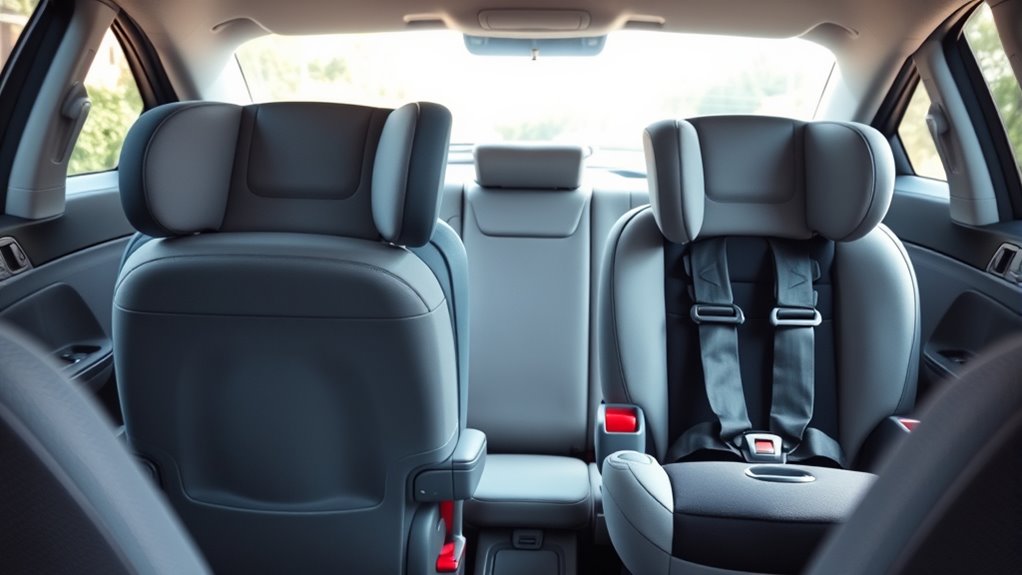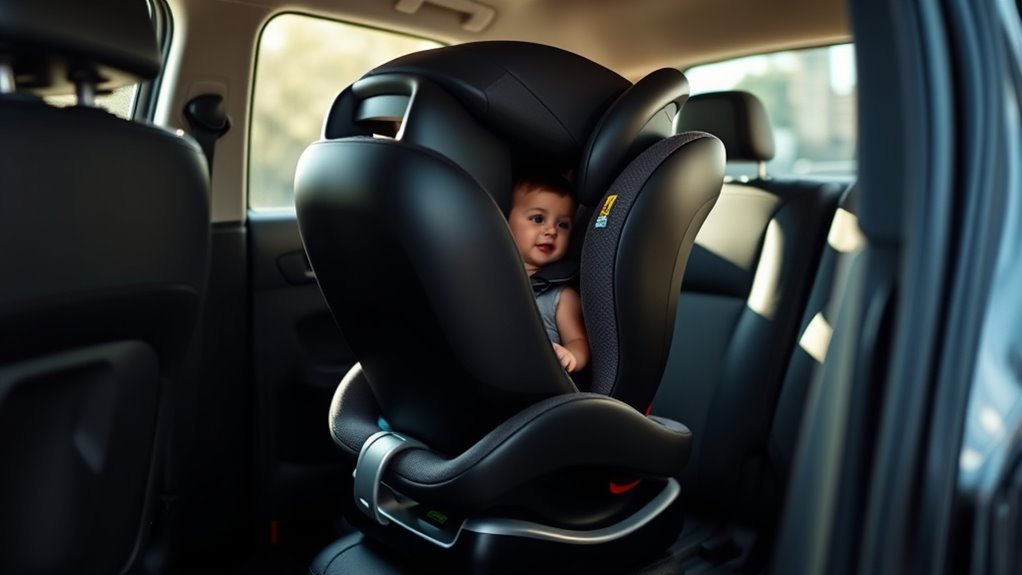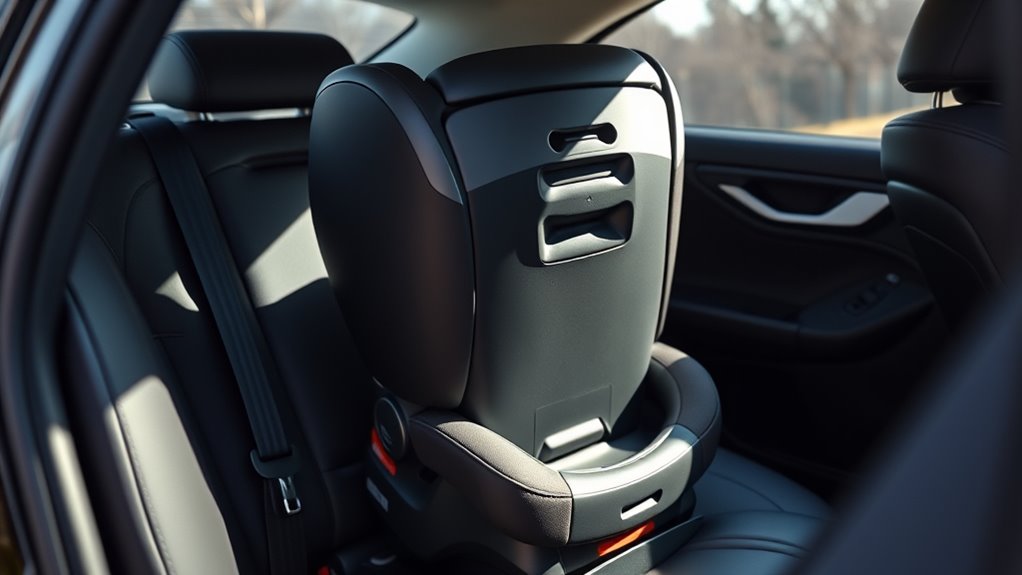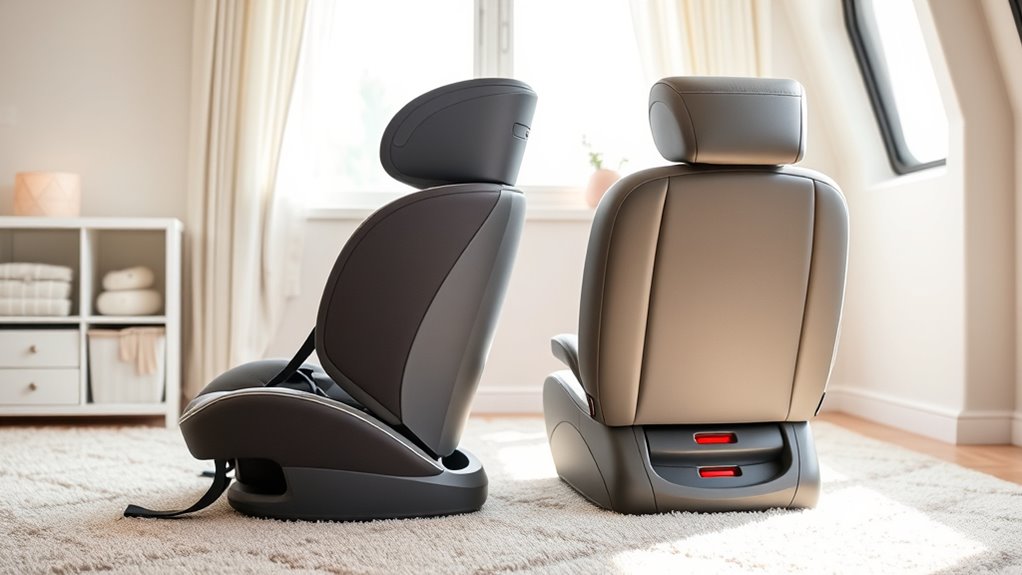To keep your child safe, use a rear-facing car seat as long as possible, following the height and weight limits. Rear-facing seats protect the head, neck, and spine during crashes, especially in their early years. When they grow out of rear-facing, switch to forward-facing seats properly installed using the LATCH system or seat belt. Ensuring correct installation and using high-quality seats can make a big difference—continue exploring these tips for maximum safety.
Key Takeaways
- Keep children rear-facing as long as they meet the seat’s weight and height limits for maximum safety.
- Transition to forward-facing seats only after reaching rear-facing weight/height limits and following manufacturer guidelines.
- Ensure proper installation using LATCH or seat belt, securing the seat tightly with minimal movement.
- Regularly check for recalls, safety notices, and maintain correct positioning for continued protection.
- Follow safety certifications and manufacturer instructions to optimize the safety and effectiveness of the car seat.
Understanding the Differences: Rear-Facing and Forward-Facing Car Seats

Understanding the differences between rear-facing and forward-facing car seats is essential for keeping your child safe. As your child grows, they go through a lifecycle progression, requiring different car seat types to ensure proper protection. Rear-facing seats are designed for infants and toddlers, providing better support for their head, neck, and spine during a crash. Safety regulations recommend keeping your child rear-facing as long as possible, often until they reach the maximum weight or height limit for their seat. Forward-facing seats, suitable for older children, include a harness and allow your child to sit upright. Knowing these distinctions helps you follow safety regulations and make informed decisions as your child advances from one car seat type to the next, ensuring continuous safety. Additionally, car seat installation plays a critical role in maximizing safety and must be done correctly to provide optimal protection.
Benefits of Staying Rear-Facing Longer

Keeping your child rear-facing for as long as possible offers essential safety benefits because their head, neck, and spine are better supported in the event of a crash. Extended rear facing reduces the risk of severe injury, especially in frontal collisions. Studies show children are safer when kept rear-facing beyond the minimum age, sometimes until age 4. The safety benefits are clear: the car seat absorbs impact and distributes crash forces evenly, minimizing injury. To highlight this, consider the table below:
| Age Range | Typical Seat Position | Main Safety Benefit |
|---|---|---|
| 1-2 years | Rear-facing | Protects head, neck, spine |
| 3-4 years | Rear-facing | Extended safety benefits |
| 4+ years | Forward-facing (optional) | Transition when appropriate |
Extended rear facing offers unrivaled safety benefits during your child’s essential early years. Additionally, understanding the importance of proper installation is crucial to maximizing safety. Ensuring the seat is installed correctly can significantly enhance protection and reduce risks associated with improper setup. Moreover, selecting a high-quality car seat with safety certifications can provide additional peace of mind. Regularly checking for recalls or safety notices ensures that your child’s car seat remains a safe choice over time. Proper use and installation are vital components of car seat safety, helping to ensure your child’s protection in every trip.
Expert Tips for Proper Car Seat Installation

Properly installing your child’s car seat is essential for ensuring maximum safety, and doing it correctly can make all the difference in a crash. To avoid common installation mistakes, always double-check that the seat is securely anchored and that the harness is snug. Follow the manufacturer’s instructions carefully, paying attention to safety certifications like FMVSS 213, which ensure the seat meets safety standards. Avoid using outdated or unapproved seats, as they might not offer adequate protection. Guarantee the seat is installed tightly with minimal movement, and use the LATCH system or seat belt as recommended. Regularly inspect the installation and readjust if necessary, especially after long trips or seat repositioning. Proper installation provides peace of mind and maximizes your child’s safety. Additionally, understanding car seat safety guidelines can help you make informed decisions about your child’s protection. Ensuring that the seat is installed with proper techniques can further reduce the risk of injury.
Frequently Asked Questions
When Is My Child Ready to Switch From Rear-Facing to Forward-Facing?
You should consider switching your child from rear-facing to forward-facing once they reach age milestones typically around 2 years old, but growth indicators are more important. Look for signs like your child’s height and weight meeting the car seat’s limits. Keep them rear-facing as long as possible for safety, usually until they are at least 2 years old or surpassing the seat’s height and weight restrictions.
How Do I Know if My Car Seat Is Installed Correctly?
You’re right to want to get it just right; it’s a case of “measure twice, cut once.” To guarantee your car seat is installed correctly, check the seat belt fit— it should be snug without slack. The harness should fit snugly against your child’s chest, with no pinching or slack. Tighten and secure all straps and anchors, then give everything a firm shake to confirm it’s sturdy and safe.
Can I Use an Expired or Damaged Car Seat?
You shouldn’t use an expired or damaged car seat because car seat expiration guarantees safety standards are met, and damaged car seats may have compromised structures or harnesses. Expiration dates are typically printed on the label, so check yours regularly. Using a seat past its expiration or one with visible damage increases the risk of injury during a crash. Always replace expired or damaged seats to keep your child safe and secure.
Are There Specific Car Seat Models Better for Small Cars?
When choosing a car seat for your small car, look for models with good small car compatibility. Compact car models often need slimmer, lightweight seats that fit securely without sacrificing safety. You should prioritize seats with adjustable features and easy installation options tailored for smaller vehicles. Always check the manufacturer’s specifications to guarantee the seat fits your car’s size and offers proper safety features, making every ride safer for your little one.
How Often Should I Check My Child’s Car Seat for Safety?
You should check your child’s car seat for safety regularly, ideally once a month. Keep an eye out for any car seat recalls and follow the manufacturer’s safety inspection schedule. After any minor accident or if you notice damage or wear, perform an immediate safety check. Staying vigilant guarantees your child’s seat remains secure and safe, giving you peace of mind every time you hit the road.
Conclusion
Remember, choosing the right car seat is like planting a sturdy tree—you want strong roots to keep your little one safe. Staying rear-facing longer is your secret shield, gently cradling them like a tender embrace. When you install it correctly, you’re building a fortress of protection around your child’s journey. Trust your instincts, follow the expert tips, and watch your child’s safety grow like a mighty oak—solid, secure, and ready for every adventure ahead.










